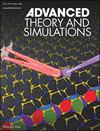从量子拓扑学和芳香性角度分析核碱基二聚体系列中存在的非共价相互作用
IF 2.9
4区 工程技术
Q1 MULTIDISCIPLINARY SCIENCES
引用次数: 0
摘要
采用“分子中的原子”的形式来评估存在于一系列天然DNA核碱基的同源和异源二聚体中的非共价相互作用,以批判性地分析相互作用线的特征和能量学。此外,原子核独立化学位移(NICS)描述符被用来界定芳香性在决定上述非共价相互作用的细节以及整体空间结构中的作用。虽然典型的观察结果是N─H··N和N─H···O氢键(HB)分别是共振辅助(部分共价)和离子键,但这一趋势的偏差也很明显。此外,研究发现,共振辅助HB在由芳香骨架组成的二聚体结构中的传统概念(即,含有HB供体片段的环的芳香性增加与含有HB受体原子/基团的环的芳香性降低相结合)并不严格适用于核碱基。通过能量分解分析,证明了空间位阻因素对所研究的HBs稳定性的影响。最后,分析解决了非天然核碱基7-氮杂吲哚是否真的是一个很好的核碱基模拟物的难题。本文章由计算机程序翻译,如有差异,请以英文原文为准。

Analysis of Non-Covalent Interactions Present within a Series of Nucleobase Dimers from the Perspective of Quantum Topology and Aromaticity
“Atoms in Molecules” formalism is implemented to assess the non-covalent interactions present within a series of homo and heterodimers of the natural DNA nucleobases to critically analyze the characteristics and the energetics of the interaction lines. Furthermore, the Nucleus independent chemical shift (NICS) descriptor is employed to demarcate the role of aromaticity in dictating the specifics of the said non-covalent interactions as well as the overall spatial architectures. Although, the typical observation is that the N─H····N and the N─H····O hydrogen bonds (HB) are resonance assisted (partially covalent) and ionic respectively, deviation from this trend is also apparent. Moreover, it is found that the conventional notion of resonance assisted HBs in a dimeric structure consisting of aromatic skeletons (i.e., an increase in thearomaticity of the ring containing the HB donor moiety coupled with a concomitant decrease in the aromaticity of the ring containing the HB acceptor atom/group) is not strictly applicable to the nucleobases. The influence of steric factor in the stabilizations associated with the studied HBs is justified via Energy Decomposition Analysis. Finally, the analyses address the conundrum of whether the unnatural nucleobase 7-azaindole is really a good nucleobase mimic.
求助全文
通过发布文献求助,成功后即可免费获取论文全文。
去求助
来源期刊

Advanced Theory and Simulations
Multidisciplinary-Multidisciplinary
CiteScore
5.50
自引率
3.00%
发文量
221
期刊介绍:
Advanced Theory and Simulations is an interdisciplinary, international, English-language journal that publishes high-quality scientific results focusing on the development and application of theoretical methods, modeling and simulation approaches in all natural science and medicine areas, including:
materials, chemistry, condensed matter physics
engineering, energy
life science, biology, medicine
atmospheric/environmental science, climate science
planetary science, astronomy, cosmology
method development, numerical methods, statistics
 求助内容:
求助内容: 应助结果提醒方式:
应助结果提醒方式:


